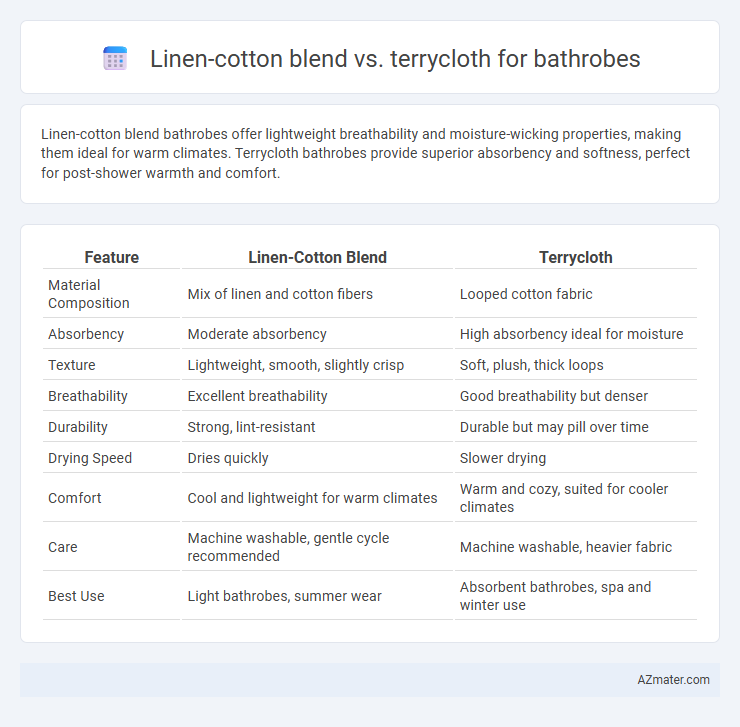Linen-cotton blend bathrobes offer lightweight breathability and moisture-wicking properties, making them ideal for warm climates. Terrycloth bathrobes provide superior absorbency and softness, perfect for post-shower warmth and comfort.
Table of Comparison
| Feature | Linen-Cotton Blend | Terrycloth |
|---|---|---|
| Material Composition | Mix of linen and cotton fibers | Looped cotton fabric |
| Absorbency | Moderate absorbency | High absorbency ideal for moisture |
| Texture | Lightweight, smooth, slightly crisp | Soft, plush, thick loops |
| Breathability | Excellent breathability | Good breathability but denser |
| Durability | Strong, lint-resistant | Durable but may pill over time |
| Drying Speed | Dries quickly | Slower drying |
| Comfort | Cool and lightweight for warm climates | Warm and cozy, suited for cooler climates |
| Care | Machine washable, gentle cycle recommended | Machine washable, heavier fabric |
| Best Use | Light bathrobes, summer wear | Absorbent bathrobes, spa and winter use |
Introduction to Bathrobe Fabric Choices
Linen-cotton blend bathrobes offer a lightweight, breathable fabric ideal for warm climates, combining linen's moisture-wicking properties with cotton's softness and durability. Terrycloth, renowned for its looped pile texture, provides superior absorbency and plush comfort, making it perfect for post-shower use and cooler environments. Understanding the distinct benefits of linen-cotton blends versus terrycloth helps consumers select bathrobes tailored to specific drying needs, comfort preferences, and climate conditions.
What is Linen-Cotton Blend?
Linen-cotton blend is a textile combining natural flax fibers from linen with soft, breathable cotton, resulting in a fabric that balances durability and comfort. This blend offers moisture-wicking properties and a lightweight feel, making it ideal for bathrobes that require both absorbency and a smooth texture. Compared to terrycloth, which is thicker and more plush, linen-cotton bathrobes provide a cooler, more breathable experience while maintaining sufficient softness for everyday use.
Understanding Terrycloth Material
Terrycloth features a looped pile surface made from cotton or cotton-blend fibers, providing superior absorbency and softness ideal for bathrobes. Linen-cotton blends offer breathable, lightweight comfort but lack the plush texture and moisture-wicking properties of terrycloth. Choosing terrycloth ensures enhanced water absorption, durability, and cozy warmth after bathing compared to the more airy and textured feel of linen-cotton blends.
Comfort and Feel: Linen-Cotton vs Terrycloth
Linen-cotton blend bathrobes offer a lightweight, breathable feel with natural moisture-wicking properties, making them ideal for warmer climates and all-day comfort. Terrycloth robes provide a plush, absorbent texture that traps warmth and excels at drying off after a shower. Choosing between the two depends on whether you prioritize airy softness and cooling comfort (linen-cotton) or thick, cozy warmth and superior absorbency (terrycloth).
Absorbency Comparison
Linen-cotton blend bathrobes offer moderate absorbency due to linen's natural fiber structure combined with cotton's soft, moisture-wicking properties. Terrycloth excels in absorbency because its looped pile fabric increases surface area, making it highly effective at trapping water after baths or showers. For quick drying and high moisture absorption, terrycloth remains the superior choice, while linen-cotton blends provide a balance of breathability and moisture handling.
Durability and Longevity
Linen-cotton blend bathrobes offer superior durability due to the combined strength of flax fibers and cotton, making them resistant to wear and frequent washing. Terrycloth bathrobes, crafted from looped cotton, excel in absorbency but tend to show signs of pilling and thinning over time under heavy use. For long-lasting bathrobes, linen-cotton blends maintain structural integrity and softness significantly better than terrycloth.
Breathability and Temperature Regulation
Linen-cotton blend bathrobes offer exceptional breathability and moisture-wicking properties, making them ideal for warm and humid climates by allowing air to circulate and keeping the skin cool. Terrycloth bathrobes, composed primarily of cotton with looped fibers, provide superior absorption and warmth, perfect for cooler environments or post-bathing comfort. While linen-cotton blends excel in temperature regulation through lightweight and breathable fabric, terrycloth's thicker texture traps heat, offering insulation and softness.
Care and Maintenance Differences
Linen-cotton blend bathrobes require gentle washing with mild detergent and should be air-dried to maintain fabric integrity and prevent shrinkage, benefiting from occasional ironing to preserve a crisp texture. Terrycloth bathrobes tolerate regular machine washing and tumble drying, as the looped cotton fibers are durable and designed for high absorbency and quick care. Choosing between these fabrics depends on desired maintenance convenience and fabric durability, with linen-cotton blends needing more delicate handling and terrycloth offering straightforward cleaning.
Style and Aesthetic Appeal
Linen-cotton blend bathrobes offer a refined, lightweight texture with a natural drape that enhances a minimalist and elegant style, perfect for a modern, sophisticated look. Terrycloth bathrobes provide a plush, textured appearance with a cozy and classic aesthetic, often associated with spa and luxury comfort. The choice between these fabrics depends on whether you prefer a sleek, breathable silhouette or a thick, absorbent, and traditionally stylish bathrobe.
Which Bathrobe Fabric is Right for You?
Linen-cotton blend bathrobes offer a lightweight, breathable option ideal for warmer climates, providing durability and moisture-wicking properties that keep you comfortable after a shower. Terrycloth bathrobes, made from cotton loops, excel in absorbency and softness, making them perfect for plush comfort and quick drying, especially in cooler environments. Choosing between linen-cotton blend and terrycloth depends on your need for breathability versus absorbency, with the former suited for light, airy wear and the latter for warmth and plush coziness.

Infographic: Linen-cotton blend vs Terrycloth for Bathrobe
 azmater.com
azmater.com